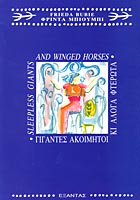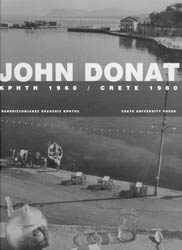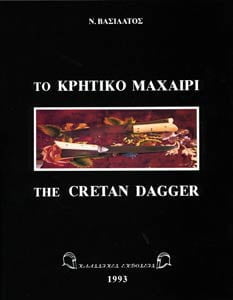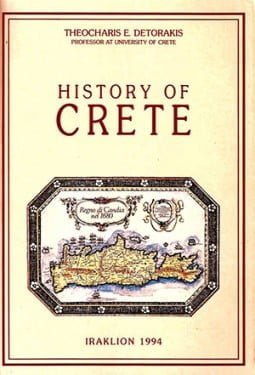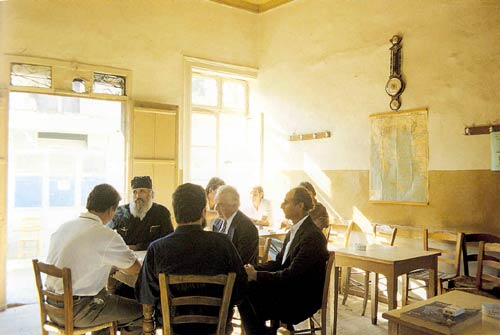The Making of the Cretan Landscape
“The Making of the Cretan Landscape” By Oliver Rackham and Jennifer Moody
Manchester University Press, 1996.
Paperback, pp 237, including index.
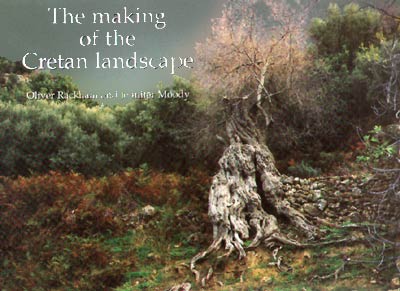
What better way to start off a new Book Review section for “Explore Crete”, than with this marvellous book?
Oliver Rackham, an English botanist and Jennifer Moody, an American geologist drew their inspiration from the seminal work of WG Hoskins: ‘The Making of the English Landscape’, first published in 1955 and still available as a Penguin paperback. This is quite possibly my favourite book on Crete currently in print (though Johan de Bakker’s “Across Crete” runs it close – more of that particular book in a later review), as there is such a wide array of subject matters that can turn one into an instant expert on multifarious topics:
The book consists of 20 chapters on various aspects of all things Cretan, neatly divided into five main headings: ‘The Environment’, ‘The Inhabitants’, ‘The Landscape’, ‘Unusual Places’ and ‘The Future’ preceded by a table of dates and brief chapters on the chronology, history and “pseudo-history” – the reality behind certain historical perceptions, such as Crete being forested in Ancient times are contested by the authors – of the ‘Great Island.’ This latter chapter is an example of one of the beauties of the book, with the authors willing to express opinions – rather than allowing it to be an inventory of bare ‘facts’ – opinions, which they are eminently qualified to make, but opinions are there to be challenged, such as the derivation of the ‘-akis’ ending of the Cretan name (more of which, below).
One could always read ‘The Making of the Cretan Landscape’ from cover to cover, though to me, this is a “dip-into” book and one that I dip into frequently. Whilst not pictorial, or perhaps large enough, to be described as a “coffee table” book, leave it on that table for a week, randomly pick a page during TV advertisements and you will learn such diverse matters as tectonic history or the history of shepherding on the island, while simultaneously losing interest in the TV programme you were watching.
Close to the heart of all aficionados of Crete is the Agrimi goat (Kri Kri), even if, like me, you have yet to spot a wild one. Did you know, however that the Kri Kri is not indigenous to the island, but was imported during Minoan times (this of course makes the two-horned ones no less interesting, as they are most certainly a subspecies of the goat family, found nowhere else on the planet and are therefore endemic to Crete) and that in fact there were no goats on the island during Pleistocene times (before the 10th millennium BC)? Plenty of deer, otters, even hippopotamuses and elephants “the size of a bullock”, but no goats.
A chapter on weather and water shows recent and historic climatic conditions ranging from rainfall to humidity with even a short paragraph on dust “…over thousands of years Cretan soils have gained dust at the rate of at least 1 mm a century…” All manner of birds, fish and other beasts (including “creepy crawlies”) are included here, though it has to be said that there are few mammals on Crete that get the blood coursing other than the aforementioned Kri Kri and the lesser spotted ‘Cretan Wildcat’ – which neither the authors or I have ever spotted – there is still a spectacular marine and bird population. Flora is equally well represented, with chapters on wild trees and plants and another on vegetation with charts showing the spread of endemic plants such as the ‘petromarula’ and a table showing the ‘properties of Cretan trees’. The mountains, gorges and the coast are, of course, a fundamental part not only in the shaping of the Cretan landscape but of the Cretan him/herself and are treated as such, with chapters not only on the geological shaping of the mountains but also on the wildlife of both the high mountains and the sea.
Overall, the book is thoroughly professionally written, but it also has a humorous edge (scorpions “lurk under stones and sting archaeologists”), with the authors revealing anecdotes such as the Cretan fear of the skink lizard (Liakoni) “…if the liakoni bites you with its mouth, call the doctor, but if it stings with you with its tail, call the priest” is a local adage. Fear not though, intrepid traveller, “the liakoni is harmless” which is more than can be said for the archaeologist-stinging scorpion.
As I mentioned in the beginning of this review, there are some contentious areas too: For instance, a paragraph on the derivation behind the diminutive form (“…as in Moodykin, Rackhamkin, etc…”), of the Cretan name ending in akis, often thought “to have been …a disparagingly familiar form of address, accepted by Cretans in order to be humble before their masters, the Turks…in reality the records show the -akis fashion began in the middle ages but did not come predominant until the nineteenth century.” In reality, the 19th century is when the Ottomans (Turks), were at their most oppressive and consequently a time that they would be most likely to have accelerated this “fashion”. Seeing as all the research for this book has evidently been so thorough however, I am willing to accept the authors’ opinion, though I would like to hear from anybody who can confirm or deny this derivation.
There have been some fabulous books written about Crete in the English language over the last couple of centuries, from Pashley’s travels of 1834, Michael Llewellyn Smith’s magnificent “The Great Island” (1965) and Christopher Thorne’s masochistic traversing of the Cretan mountains in “Between the Seas” (1992). This book is not only up to that standard, but sets a new one. If you love Crete for all its diversity and majesty this is a must-have book.
* Reviewed by Stelios Jackson on June 12 2002.
“The Making of Cretan Landscape” – Table of Contents:
List of Illustrations
Preface
List of abbreviations
Table of Dates:
1/ Chronology
2/ History, pseudo-history and the use of Evidence
The Environment:
3/ Making the mountains
4/ Weather and Water
The Inhabitants:
5/ Wild Animals
6/ Wild Trees and Plants
7/ Domestic Animals and Plants
8/ People and Settlements
The Landscape:
9/ Place Names
10/ Vegetation
11/ Vegetation history
12/ Terraces, Fields and Enclosures
13/ Boots, Mules and Roads
14/ Shepherding
15/ Buildings
16/ Sacred Landscapes
Unusual Places:
17/ The High Mountains
18/ Coasts and the Sea
19/ Islets
The Future:
20/ Conservatism and the Future
Bibliography
Index
Buy the book The Making of the Cretan Landscape from Amazon UK
© explorecrete.com All Rights Reserved. Reproduction or copying without permission is prohibited.

